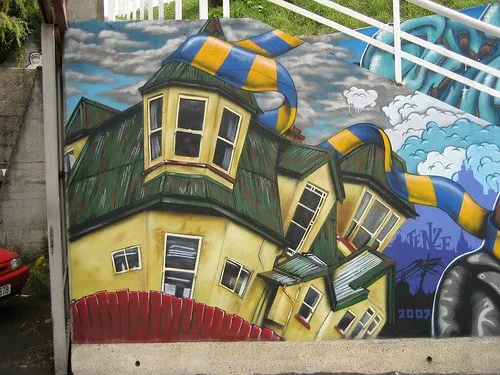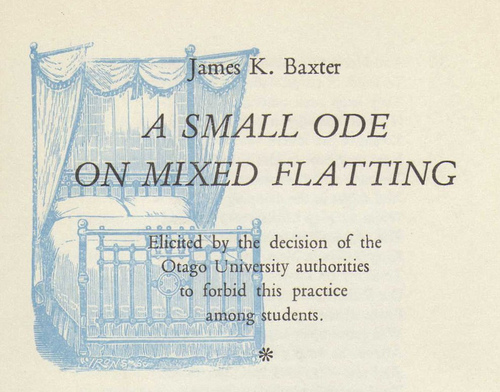Category: Other Artists
Interview with Roger Shepherd on Media 7
andrewlong:
Russell Brown at Media 7 talks with Roger Shepherd about his recent Flying Nun records re-acquisition.
Point that thing somewhere else / The Clean
“Point that thing somewhere else” / The Clean
This is one of the songs mentioned in Graeme Downes’s article referenced in an earlier blog post about the “It’s time to go flat” on Clyde Street.
Collection of Flying Nun ephemera
A wonderful, and hopefully burgeoning, collection of Flying Nun ephemera.
Collection of Flying Nun ephemera
The Scarfies Flat – 49 Brown Street
It’s commonly known as “The Scarfie’s flat”, although it doesn’t have a sign. 49 Brown Street is best known for it’s role playing a strong, silent, sinister character in the 1999 Sarkies brothers’ film, Scarfies. It can be found stolidly anchored in dilapidated grandnzd, glowering over the city of Dunedin from Cannongate.
The house had a group page on Facebook which unfortunately seems to have been taken down. It was frequented by past residence and there were several mentions of hauntings which was interesting.
Below, is a photo of a graffito of the house itself on the wall which supports the Cannongate Steps. Source.

Feeling rather stoked
A review of Carl Shuker’s Lazy Boys
I’ve just read this review (link above), and I agree largely with it. I didn’t find this a surrealistist representation of life at the time either. Aspects of the story were all all too familiar and real to me. I don’t believe this is in any way a reflection on Otago/Dunedin or a reason to disuade someone from going to the university there however. It’s more a reflection of the kind of people some young adults find themselves becoming. For some, growing up is no picnic.
A review of Carl Shuker’s Lazy Boys
A connection with Caxton Press
While browsing some old editions of Home and Building via the NZETC, I came across a wonderful article about the Caxton Press.
This is relevant to the project for a couple of reasons: the project on named flats has it genesis in a print culture study, and therefore owes a great deal to the history and culture of print in New Zealand. Secondly, Baxter’s poem “A Small Ode on Mixed Flatting” was published at Caxton.

A Small Ode On Mixed Flatting. Christchurch: The Caxton Press, [1967]. Brasch PR 9641 B3 S5.
Of additional interest to me is mention of Caxton and other NZ presses preserving the craft of printing by continuing the work begun by William Morris at a time where in the UK, industrialisation of the printing industry was subsuming it’s craft history. ‘“I began printing books,” said Morris, “with the hope of producing something which would have a definite claim to beauty, while at the same time they should be easy to read and should not dazzle the eye or trouble the intellect …”
View the article here: The Caxton Press / Brian Bell, Home and Building, Vol 18 No.1 1955, p15f
Ghetto flats in Dunedin
A story on ghetto flats in Dunedin directed by Justin Hawkes for New Zealand TV Show ‘Space’ way back in 2003.
It shows some pretty grotty flats, the important thing is that some of them are named; Hilton on Clyde and DSIR.
It’s time to go
A house at 111 Clyde Street, next to Footrot Flats, on which fans of The Clean painted the lyrics of “Sad Eyed Lady”. The flat came to be known, according to Graeme Downes, as the “It’s time to go” flat, after the final line in the song.
Great photo here of a bit of Clean graffiti by Allisonwonderlandz on flickr.com.
It’s time to go
Under Flagstaff / Law & Murray
In Visions of Dundas Street through student coloured glasses, Hamish Mckenzie recalls Dundas Street, pater familias of local scarfies, bridging the Water of Leith and slowing speeding cars with its double dose of hemorrhoids. A more gentile work referencing Dundas Street is Bernadette Hall’s Lacework, recalling the iron lace on the verandah of her childhood home at number 118.
Just around the corner from Dundas Street, Castle Street is refered to, infamously, in Baxter’s A Small Ode on Mixed Flatting, where he says he dipped his wick back in the day where mixed flatting was a social no no.
Joanna Preston recalls “… scarfie flats with names and legends passed down from pisspot to pisspot …” up the Valley, in A visit to Nicky’s place. I particularly enjoy the later, and what this infers in terms of the project I’m working on.

View the OUP page about Under Flagstaff
